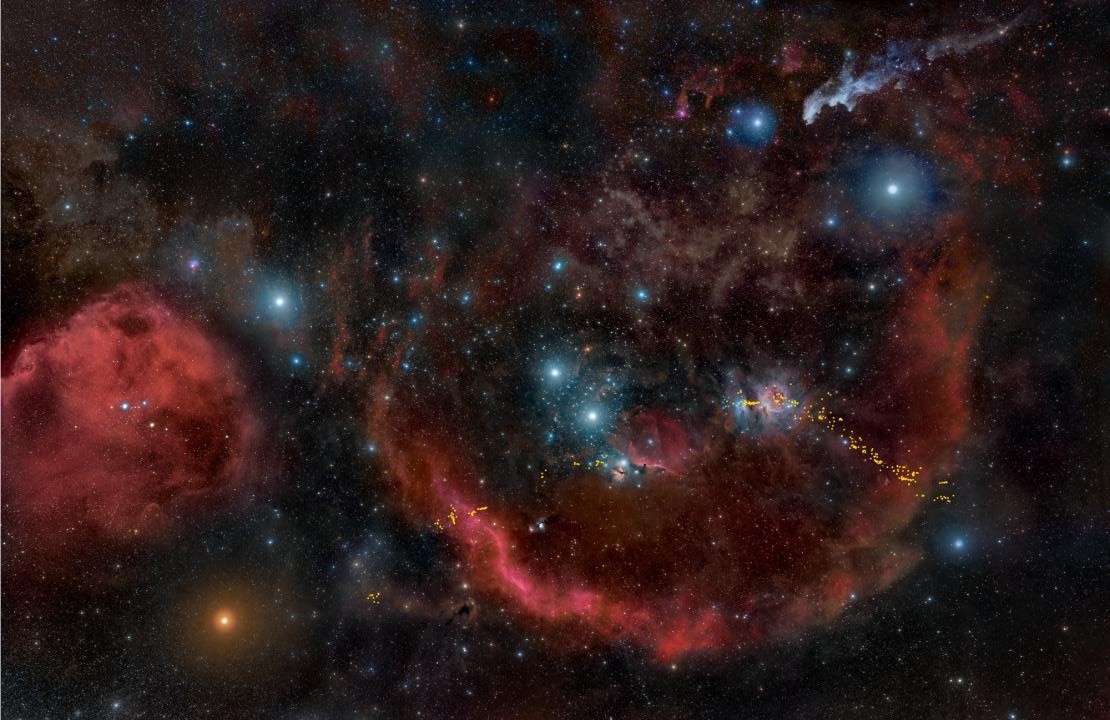Fresh research has cast doubt on the theory that energetic outbursts from young stars blows away the cocoon of gas from which they formed, which in turn prevents them from growing any further. The Milky Way plays host to over 200 billion stars, the early formation of which must now be re-examined in light of the new study.
Protostars are created over many millions of years from vast clouds of interstellar dust and hydrogen gas known as stellar nurseries. In these chaotic environments, relatively dense clumps of matter continually gain mass until they have a gravitational influence capable of triggering a nuclear fusion reaction deep in their cores. These newly born protostars are incredibly energetic, and quickly begin to emit powerful solar winds and jets of super hot gas out into the surrounding dust cloud.
Astronomers believe that, over time, this powerful outpouring of energy creates enormous cavities in the surrounding cloud. According to this theory, this relentless assault is eventually able to widen these cavities until the winds and jets of gas completely expel the once nurturing gaseous cocoon away from the protostar.
This violent action in turn cuts off the reserves of material that the star was feeding on to grow, and so is thought to have a dramatic effect on the final mass of a body as it begins its life as a star.
It is currently estimated that only 30 percent of a cloud’s mass ends up being incorporated into a newly born protostar. However, a new study making use of observations taken by a fleet of famous orbital telescopes has cast doubt on this well-established theory.
The astronomers behind the new research used data from the European Space Agency’s Herschel Space Telescope along with NASA’s Hubble telescope and the now-defunct Spitzer observatory.
Their goal was to analyze the disruptive effect that young stellar bodies in the Orion Complex – a major star-forming nursery located roughly 1,300 light years From Earth – was having on the surrounding gaseous environment. More specifically, they were attempting to shed light on whether the disruptive influence was preventing gas from transferring onto a star and adding to its mass.

Image courtesy of R. B. Andreo, DeepSkyColors.com; Data Overlay: NASA, ESA, STScI, N. Habel and S. T. Megeath (University of Toledo)
A grand total of 304 protostars were analyzed as part of the study. The researchers first sorted the young stellar bodies by age, by analyzing each star’s light output as captured in observations from the Herschel and Spitzer telescopes. The team then turned to images captured of the cavities that had formed around the stars, taken by Hubble’s Wide Field Camera 3, Near Infrared Camera, and Multi-object Spectrometer.
Armed with this data, and the knowledge of the protostars’ ages gleaned from the Herschel/Spitzer observations, the researchers were able to compare details in gas cloud cavities at various stages of their evolutionary journeys. Detailed measurements were made of the cavities’ structures, shapes, and sizes, which in turn allowed the astronomers to work out the amount of gas that had been cleared away by the energetic stellar activity.
“We find that at the end of the protostellar phase, where most of the gas has fallen from the surrounding cloud onto the star, a number of young stars still have fairly narrow cavities,” comments Prof. Tom Megeath of the University of Toledo, one of the authors of the new study. “So, this picture that is still commonly held of what determines the mass of a star and what halts the infall of gas is that this growing outflow cavity scoops up all of the gas. This has been pretty fundamental to our idea of how star formation proceeds, but it just doesn’t seem to fit the data here.”
Further observations from upcoming telescopes will be needed to examine the mystery, and deduce whether there is a hitherto unknown process preventing the vast majority of the gas in a cloud from falling into the star, and dictating star mass.
A paper on the research has been published in The Astrophysical Journal.
Source: NASA
Source of Article